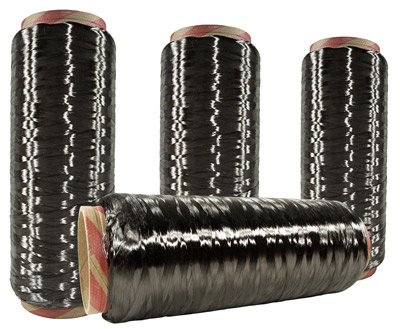Can carbon fiber solve the oil crisis? 碳纤维可以解决石油危机吗?
What Is Carbon Fiber?
Before you can understand how carbon fiber can help solve the oil crisis, you have to understand what it is. Carbon fiber is a super strong material that's also extremely lightweight. Engineers and designers love it because it's five times as strong as steel, two times as stiff, yet weighs about two-thirds less. Carbon fiber is basically very thin strands of carbon -- even thinner than human hair. The strands can be twisted together, like yarn. The yarns can be woven together, like cloth. To make carbon fiber take on a permanent shape, it can be laid over a mold, then coated with a stiff resin or plastic (kind of like how you would make something out of papier-mâché by putting newspaper strips over a mold, then adding paste to force it to hold the shape).

Spools of carbon fiber will soon be woven into a strong and lightweight material.
Most car components are made of steel. Replacing steel components with carbon fiber would reduce the weight of most cars by 60 percent [source: USA Today]. That 60 percent drop in weight would, in turn, reduce that car's fuel consumption by 30 percent and cut greenhouse gas and other emissions by 10 to 20 percent [source: Oak Ridge National Laboratory]. That's a huge fuel savings, even without changing the car's engine. With a lighter carbon fiber body, car makers could build cars with smaller, more efficient engines, or increase the use of electric engines, resulting in even more fuel savings. Reducing weight, increasing fuel efficiency and allowing for the development of different kinds of engines: That's how carbon fiber can solve the oil crisis.
But is it safe?
Safety is a major concern for car buyers. A car that gets 100 miles to the gallon won't do you much good if it won't help you survive a crash. The good news is, carbon fiber is just as safe as steel. Computer crash simulations show that carbon fiber cars perform just as well as steel cars. In fact, Formula One race cars are all carbon fiber, something that's a safety -- not performance -- regulation.
But wait, if carbon fiber is so great, why isn't it in widespread use in cars?
The Difficulties of Carbon Fiber
Only a few cars available at your local dealership use carbon fiber. The BMW M6 has some carbon fiber panels on its body, as does the Chevrolet Corvette ZR1 and the Ford GT. The Audi R8 also includes some carbon fiber. What do all these cars have in common? They cost a lot of money -- most start above $100,000. It's rare to see a car with carbon fiber because it's expensive! Ten years ago, carbon fiber cost $150 a pound. Now, the price is around $10 a pound [source: Zoltek]. Steel, on the other hand, costs less than a dollar per pound. Many analysts say that for carbon fiber to make it into widespread use in cars, the price will have to drop to about $5 per pound [source: Oak Ridge National Laboratory]. Cost is the main hurdle carbon fiber will have to overcome before it can provide a viable energy solution.

BMW has now incorporated carbon fiber into its M6 model.
The second hurdle is waste disposal. When a typical car breaks down, its steel can be melted and used to construct another car (or building, or anything else made of steel). Carbon fiber can't be melted down, and it's not easy to recycle. When it is recycled, the recycled carbon fiber isn't as strong as it was before recycling. Carbon fiber recycled from a car isn't strong enough to be used in building another car. That's a big issue. Having more cars use carbon fiber would save a lot of oil, but it could also generate a lot of waste.
Aluminum: the other oil saver?
With carbon fiber costing so much, car makers are looking toward other materials to make cars lighter. One is aluminum. Though aluminum isn't as strong as steel, it's much lighter. That makes it a good material for some car components, like engine parts and some sections of the chassis. Because it's not as strong as steel, it doesn't work everywhere, but its low cost and light weight have made it a common material in modern cars.
As it stands now, carbon fiber could solve the oil crisis. It's lightweight, durable and safe. But it's also expensive and difficult to recycle. For now, it looks like carbon fiber is just going to be one of many solutions to the oil crisis. When combined with efficient engines, other, cheaper materials and a change in driving habits, carbon fiber is just one piece of the energy puzzle.